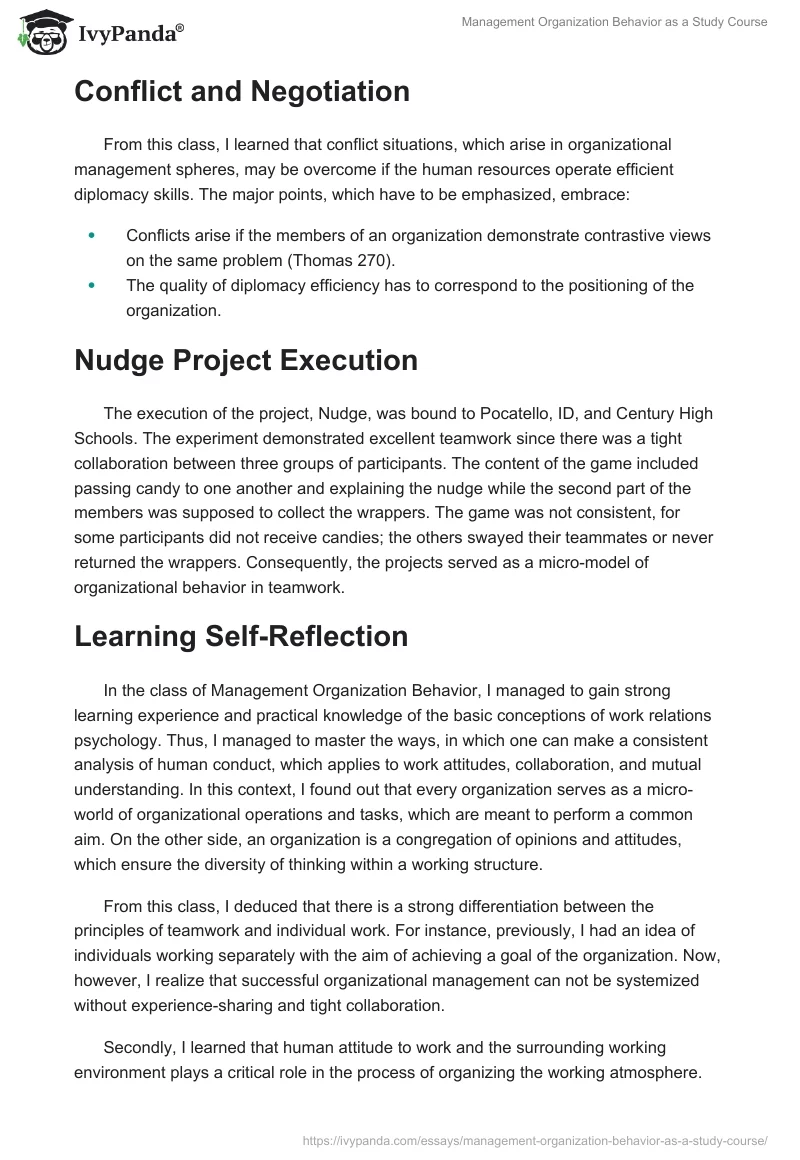Communication
From the class of Management Organization Behavior, I managed to deduce that communication makes a critical influence on organizational behavior development since it defines the nature of interpersonal relations within any working structure. The major points, which I can outline in this context include:
- Friendly relationships between the employees within an organization empower the workers for high-quality work.
- The maintenance of good partnership bonds between organizations stimulates experience sharing (Mohr and Spekman 136).
- Constant improvement of communication techniques facilitates the basic organizational processes and operations.
Leadership
The class inspired knowledge of leadership fundamentals. In the process of learning, I found out that organizational success is propelled by the power of will, initiative, creative thinking, and leadership qualities. Specifically, the following principles were outlined:
- The ability to establish one’s own operational innovation or the pattern of behavior in an organization refers to the features of a true leader (Podsakoff et al. 109).
- The quality of leadership defines the virtues of an organization.
Conflict and Negotiation
From this class, I learned that conflict situations, which arise in organizational management spheres, may be overcome if the human resources operate efficient diplomacy skills. The major points, which have to be emphasized, embrace:
- Conflicts arise if the members of an organization demonstrate contrastive views on the same problem (Thomas 270).
- The quality of diplomacy efficiency has to correspond to the positioning of the organization.
Nudge Project Execution
The execution of the project, Nudge, was bound to Pocatello, ID, and Century High Schools. The experiment demonstrated excellent teamwork since there was a tight collaboration between three groups of participants. The content of the game included passing candy to one another and explaining the nudge while the second part of the members was supposed to collect the wrappers. The game was not consistent, for some participants did not receive candies; the others swayed their teammates or never returned the wrappers. Consequently, the projects served as a micro-model of organizational behavior in teamwork.
Learning Self-Reflection
In the class of Management Organization Behavior, I managed to gain strong learning experience and practical knowledge of the basic conceptions of work relations psychology. Thus, I managed to master the ways, in which one can make a consistent analysis of human conduct, which applies to work attitudes, collaboration, and mutual understanding. In this context, I found out that every organization serves as a micro-world of organizational operations and tasks, which are meant to perform a common aim. On the other side, an organization is a congregation of opinions and attitudes, which ensure the diversity of thinking within a working structure.
From this class, I deduced that there is a strong differentiation between the principles of teamwork and individual work. For instance, previously, I had an idea of individuals working separately with the aim of achieving a goal of the organization. Now, however, I realize that successful organizational management can not be systemized without experience-sharing and tight collaboration.
Secondly, I learned that human attitude to work and the surrounding working environment plays a critical role in the process of organizing the working atmosphere. Mainly, it became clear to me that one can not sustain fruitful work if he does not have a positive perception of his performance. Thus, an attitude is a defining feature of a behavioral mechanism. In this context, I certified the theory, according to which, psychological contract contributes to organizational commitment (Sturges et al. 822).
The most memorable thing, which was mastered by me in this course, was the relationship between leadership qualities and organizational success. The Nudge experiment, which demonstrated situational opportunities of management procedures, showed that the variety of human behavioral mechanisms and work perceptions put some people on the leading positions in organizational management while the others are suppressed in the process of leadership revelation (Johns 387).
From this class, I derived a system of behavioral tools, which can be used in organizational management. Specifically, I learned that one should develop a range of positive leadership qualities, moods, and perceptions, which show a deep inquiry into the system of organizational management. Primarily, I managed to make a distinction between emotions and moods. Thus, I learned that the development of emotional perceptions is not sufficient for the improvement of working behavior. In contrast, I deduced that a platform of occupational attitudes, which predetermine the quality of work, is formed by moods since they are long-lasting and mark a stable behavioral system (Luthans and Avolio 293).
The class imposed a strong influence on my day-to-day behavior, for I learned that organizational management defines both work perceptions and daily attitudes towards different aspects of life. Mainly, I found out that people, who reveal initiatives and leadership qualities, may take an upper hand in their routine communications, arguments, and discussions. Such individuals possess self-awareness and can identify their positions and opinions in any environment. The conduct, which is demonstrated by leaders, exemplifies the model of behavioral management, which organizes successful work, as well as a personal standpoint, which identifies a power of will and personal strength.
Works Cited
Johns, Gary. “The Essential Impact of Context on Organizational Behavior.” Academic Management Review 31.2 (2006): 386-408. Print.
Luthans, Fred, and Bruce Avolio. “The “Point” of Positive Organizational Behavior.” Journal of Organizational Behavior 30 (2009): 291-307. Print.
Mohr, Jakki, and Robert Spekman. “Characteristics of Partnership Success: Partnership Attributes, Communication Behavior, and Conflict Resolution Techniques.” Strategic Management Journal 15.2 (2004): 135-152. Print.
Podsakoff, Philip, Scott McKenzie, Robert Moorman, and Richard Fetter. “Transformational Leader Behaviors and Their Effects on Followers’ Trust in Leader, Satisfaction, and Organizational Citizenship Behaviors.” The Leadership Quarterly 1.2 (2010): 107-142. Print.
Sturges, Jane, Neil Conway, David Guest, and Andreas Liefooghe. “Managing the Career Deal: The Psychological Contract as a Framework for Understanding Career Management, Organizational Commitment and Work Behavior.” Journal of Organizational Behavior 26.7 (2005): 821-838. Print.
Thomas, Kenneth. “Conflict and Conflict Management: Reflections and Update.” Journal of Organizational Behavior 13.3 (2002): 265-274. Print.


